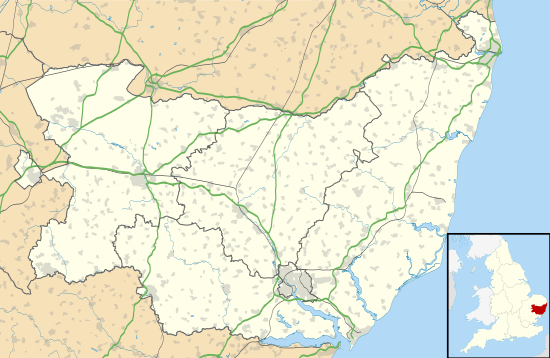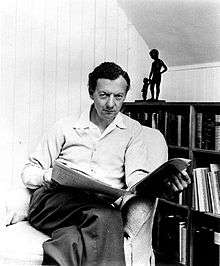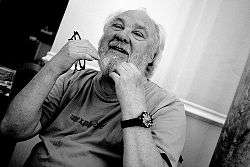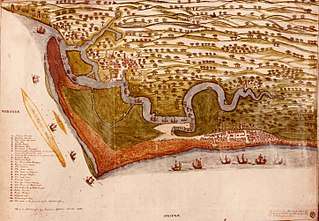Aldeburgh
Aldeburgh (/ˈɔːlbərə/ AWL-bər-ə) is an English town on the North Sea coast in the county of Suffolk, to the north of the River Alde. It was home to the composer Benjamin Britten and has been the centre of the international Aldeburgh Festival of arts at nearby Snape Maltings, founded by Britten in 1948.[2][3] It remains an arts and literary centre, with an annual poetry festival and several food festivals and other events.[2] As a Tudor port, Aldeburgh gained borough status in 1529 under Henry VIII. Its historic buildings include a 16th-century moot hall and a Napoleonic-era Martello Tower. Second homes make up about a third of its housing.[4] Visitors are drawn to its Blue Flag shingle beach and fisherman huts, where fresh fish are sold daily, by Aldeburgh Yacht Club, and by its cultural offerings. Two family-run fish and chip shops are listed among the best in the country.[5]
| Aldeburgh | |
|---|---|
 The Moot Hall | |
 Aldeburgh Location within Suffolk | |
| Population | 2,466 (2011 Census)[1] |
| OS grid reference | TM463566 |
| Civil parish |
|
| District |
|
| Shire county | |
| Region | |
| Country | England |
| Sovereign state | United Kingdom |
| Post town | ALDEBURGH |
| Postcode district | IP15 |
| Dialling code | 01728 |
| Police | Suffolk |
| Fire | Suffolk |
| Ambulance | East of England |
| UK Parliament | |

| |
History
The name "Aldeburgh" derives from the Old English ald (old) and burh (fortification),[6] although this structure, along with much of the Tudor town, has now been lost to the sea. In the 16th century, Aldeburgh was a leading port, and had a flourishing shipbuilding industry. The flagship of the Virginia Company, the Sea Venture is believed to have been built here in 1608. Aldeburgh's importance as a port declined as the River Alde silted up and larger ships could no longer berth. It survived mainly on fishing until the 19th century, when it also became a seaside resort. Much of its distinctive, whimsical architecture dates from that period. The river is now home to a yacht club and a sailing club.
Geography
Aldeburgh is on the North Sea coast, about 87 miles (140 kilometres) north-east of London, 20 mi (32 km) north-east of Ipswich and 23 mi (37 km) south of Lowestoft. Locally it is 4 mi (6 km) south of the town of Leiston and 2 mi (3 km) south of the village of Thorpeness. It lies just north of the River Alde, with the narrow shingle spit of Orford Ness all that stops the river meeting the sea at Aldeburgh – instead it flows another 9 mi (14 km) to the south-west.
The beach is mainly shingle and wide in places, allowing fishing boats to draw up onto the beach above the high tide, but it narrows at the neck of Orford Ness. The shingle bank allows access to the Ness from the north, passing a Martello tower and two yacht clubs at the site of the former village of Slaughden. Aldeburgh was flooded in the North Sea flood of 1953, after which its flood defences were strengthened.[7] The beach received a Blue Flag rural beach award in 2005.
The town is within the Suffolk Coast and Heaths Area of Outstanding Natural Beauty (AONB), with a number of Sites of Special Scientific Interest (SSSI) and nature reserves in its locality. The Alde-Ore Estuary SSSI covers the area surrounding the river from Snape to its mouth, including the whole of Orford Ness. This contains several salt marsh and mudflat habitats.[8] The Leiston-Aldeburgh SSSI extends from the northern edge of the town over a range of habitats, including grazing marsh and heathland.[9][10] It includes Thorpeness Mere and the North Warren RSPB reserve, an area of wildlife and habitat conservation, and nature trails run by the Royal Society for the Protection of Birds.[10][11]
Two smaller geological SSSI units lie on the southern edges. Aldeburgh Brick Pit, of 0.84-hectare (2.1-acre), shows a clear stratigraphy of Red Crag deposits above Corralline Crag.[12] Aldeburgh Hall Pit is a shallow pit 0.8 ha (2.0 acres) in area, featuring a section of Corralline Crag. It is seen as one of the best sites in Britain for Neogene fauna.[13]
The town's churches include the pre-Reformation Anglican parish church of St Peter and St Paul and the Catholic Church of Our Lady and St Peter.
Governance

Aldeburgh has a town council and lies within the East Suffolk non-metropolitan district. Aldeburgh ward, including Thorpeness and other communities, had a population of 3225 in the 2011 census, when the mean age of the inhabitants was 55 and the median age 61.[14]
It is within the Suffolk Coastal parliamentary constituency represented by Therese Coffey, having had John Gummer for a member from 1983 to 2010. It is seen as a safe seat for the Conservatives.
Aldeburgh was a Parliamentary Borough from 1571, and returned two Members of Parliament, the right to vote being vested in the town's freemen. By the mid-18th century it was classed as a rotten borough, as the votes were controlled by a City of London merchant, Thomas Fonnereau:[15] and memorably described it as "a venal little borough in Suffolk".[16] It lost its representation under the Great Reform Act of 1832.
In 1908 Aldeburgh became the first British town to elect a female mayor: Elizabeth Garrett Anderson, whose father, Newson Garrett, had been mayor in 1889. In 2006, Sam Wright became Aldeburgh's town crier and mace bearer at 15, and so the youngest in the world.[17]
Transport
Aldeburgh is linked to the main A12 at Friday Street in Benhall, by the A1094 road. The B1122 leads to Leiston. There are bus services to Leiston, southward to Woodbridge and Ipswich, and northward to Halesworth.[18]
The nearest railway station is Saxmundham on the East Suffolk Line.[19] This provides hourly weekday services to Ipswich (for London Liverpool Street station) and Lowestoft (for Norwich).[18] Aldeburgh railway station opened in 1860 as the terminus of the Aldeburgh Branch Line from Saxmundham, but was closed in 1966 under the Beeching Axe.
Landmarks

Lifeboat station
The RNLI station in the town was operating two lifeboats in 2016.
Moot Hall
The Aldeburgh Moot Hall is a Grade I listed timber-framed building, used for council meetings for over 400 years. The Town Clerk's office remains there and it houses the local museum. It was built in about 1520 and altered in 1654. The brick and stone infilling of the ground floor is later. The hall was restored and the external staircase and gable ends were rebuilt in 1854–1855 under the direction of R. M. Phipson, chief architect of the Diocese of Norwich, in which Aldeburgh then stood. There are 64 other listed historic buildings and monuments in the town.[20]
Martello Tower

A unique quatrefoil Martello Tower stands at the isthmus leading to the Orford Ness shingle spit. It is the largest and northernmost of 103 English defensive towers built in 1808–1812 to resist a threatened Napoleonic invasion. The Landmark Trust now runs it as holiday apartments.[21] From May 2015 to May 2016, an Antony Gormley statue was on display on the roof as part of his LAND art installation.
The Martello Tower is the only surviving building of the fishing village of Slaughden, which had been washed away by the North Sea by 1936. Near the Martello Tower at Slaughden Quay are barely visible remains of the fishing smack Ionia. It had become stuck in the treacherous mud of the River Alde, and was then used as a houseboat. In 1974 it was burnt, as it had become unsafe.
Fort Green Mill
The four-storey windmill at the southern end of the town was built in 1824 and converted into a dwelling in 1902.
WW2 tank trap
A WW2 tank trap can be seen next to Slaughden Road.[22]
Scallop

On Aldeburgh's beach, a short distance north of the town centre, stands a sculpture called Scallop, dedicated to Benjamin Britten, who would walk along the beach in the afternoons. Created from stainless steel by the Suffolk-based artist Maggi Hambling, it stands 15 feet (4.6 metres) high, and was unveiled in November 2003.[23] The piece is made up of two interlocking scallop shells, each broken, the upright shell being pierced by the words, "I hear those voices that will not be drowned," taken from Britten's opera Peter Grimes. The sculpture is meant to be enjoyed both visually and in a tactile way: people are encouraged to sit on it and watch the sea.
The upright portion of the shell splits into three sections positioned at different angles. The positioning of these effects a visual transformation, depending on the vantage point from which the sculpture is viewed.
The sculpture is controversial in the local area,[24] with some local residents considering it spoils the beach.[23] It has been vandalised with graffiti and paint on 13 occasions.[23] There have been petitions for its removal and for its retention.[23]
 Detail of Scallop viewed from the sea in July 2019
Detail of Scallop viewed from the sea in July 2019 Scallop, by Maggie Hambling, as viewed from the path leaving Aldeburgh in the direction of Thorpeness, from which vantage it takes the shape of a seabird
Scallop, by Maggie Hambling, as viewed from the path leaving Aldeburgh in the direction of Thorpeness, from which vantage it takes the shape of a seabird Scallop, viewed from the path between Aldeburgh and Thorpeness, looking back towards Aldeburgh, from which vantage the sculpture takes the shape of two men in a boat, referencing a central incident from the opera Peter Grimes
Scallop, viewed from the path between Aldeburgh and Thorpeness, looking back towards Aldeburgh, from which vantage the sculpture takes the shape of two men in a boat, referencing a central incident from the opera Peter Grimes
First World War
A nearby aerodrome, Royal Naval Air Station Aldeburgh, was used in the First World War as a Night Landing Ground and for training observers.[25]
Notable residents

.jpg)


- Henry Johnson (c. 1659–1719), "greatest shipbuilder and shipowner of his day" and MP for Aldeburgh, 1689–1719
- George Crabbe (1754–1832), poet born in Aldeburgh, which features in his poems The Village and The Borough. The latter speaks of a fisherman named Peter Grimes, on whose story Benjamin Britten's opera of that name was based.[26][27]
- Elizabeth Garrett Anderson (1836–1917) was the first woman to qualify as a physician and surgeon in Britain, co-founder of first hospital staffed by women, first female dean of a British medical school, first female doctor of medicine in France, first woman in Britain elected to a school board, and as Mayor of Aldeburgh, first female mayor and magistrate in Britain.[28]
- Annie Hall Cudlip, (1838–1918) writer, novelist and short story writer, was born in Aldeburgh.[29]
- Agnes Garrett (1845–1935), suffragist and interior designer, founded the Ladies Dwellings Company.[30]
- Dame Millicent Fawcett (1847–1929), suffragist, feminist and writer, was born in Aldeburgh, where she set her one novel, Janet Doncaster.[31]
- M. R. James (1862–1936), author, set a story, "A Warning to the Curious", in "Seaburgh" (Aldeburgh). Landmarks such as the Martello tower and White Lion Hotel feature.[32]
- Joan Cross (1900–1993), soprano and theatre director who created several Britten opera roles, is buried in the town churchyard.[33]
- Gerry Fiennes (1906–1985), railway manager and author, was Mayor of Aldeburgh in 1976.
- H. T. Cadbury-Brown (1913–2009), architect
- Benjamin Britten (1913–1976) moved to the town in 1942. He, Eric Crozier (1914–1994) and Peter Pears (1910–1986) founded the Aldeburgh Festival and Aldeburgh Music Club. He moved with Pears into The Red House in 1957. They lie side by side in the town churchyard.[34]
- Ruth Rendell (1930–2015), author of thrillers and psychological murder mysteries, created Chief Inspector Wexford.[35]
- Rt Revd Sandy Millar (born 1939), once Vicar of Holy Trinity Brompton[36] and co-founder of the Alpha course, lives in Aldeburgh.
- Sue Lloyd (1939–2011), model and actress, played Barbara Hunter in Crossroads.[37]
- Christine Truman (born 1941), Grand Slam tennis event winner, lives in Aldeburgh.[38]
- Malcolm Bowie (1943–2007), Master of Christ's College, Cambridge, 2002–2006[39]
- Peter Sinfield (born 1943), songwriter with the progressive rock act King Crimson, lives in Aldeburgh.[40]
- Cevanne Horrocks-Hopayian (living), composer, lives in Aldeburgh, on the border with Thorpeness.[41]
- Roy Keane (born 1971), footballer, became an Aldeburgh resident in 2009 on taking over as manager of Ipswich Town.[42]
- Miranda Raison (born 1977), actress, has a weekend cottage in Aldeburgh and belongs to Aldeburgh Golf Club.[43]
- Isabella Summers (born 1980), songwriter, producer and remixer (Florence and the Machine), is an Aldeburgh native.[44]
Culture
Outside the town, the Snape Maltings is the venue for the Aldeburgh Festival held every June.
Aldeburgh Music Club was founded by Benjamin Britten and Peter Pears in 1952.[45] It has evolved over the years into one of East Anglia's leading choirs, with about 100 members and over 120 supporting patrons. The choir rehearses from early September to late May each year and holds three major performances, two of them at Snape Maltings Concert Hall.
The annual Aldeburgh Carnival in August has taken place at least since 1892 and possibly as far back as 1832, when "Ye Olde Marine Regatta" was mentioned. The focal point today is a Carnival Procession featuring locals and visitors dressed in home-made costumes and on floats, often with a topical or local theme. In the evening, a parade with Chinese lanterns and a firework display are traditional. The procession has been led for over 30 years by Chief Marshal Trevor Harvey, also a Carnival Committee member for over 50 years.[46]
The Suffolk Craft Society hold an annual themed exhibition in the Peter Pears Gallery over July and August, showing the work of its members.
The town of Aldeburgh or "Owlbarrow" is the setting of a series of children's illustrated books centred on Orlando (The Marmalade Cat) written by Kathleen Hale, who spent holidays in the town. Many of the illustrations in the books feature landmarks in the town, including the Moot Hall. The town features in the thriller Cross of Fire by novelist Colin Forbes, as do the nearby villages of Dunwich and Snape Maltings.[47] James Herbert based his book The Jonah in the area, using several names represented in the local area for characters, including Slaughden.
Aldeburgh (spelt there Aldborough) is the location of a key scene in Wilkie Collins's novel No Name, where Captain Wragge and Magdalen Vanstone enact their conspiracy against Noel Vanstone and Mrs Lecount. The town's Martello Tower is a landmark mentioned. Aldeburgh also features in Joseph Freeman's novel Arcadia Lodge, as "Seaburgh", and in the M. R. James story "A Warning To The Curious". The Maggi Hambling sculpture features in an early scene, as do various other notable landmarks.
Fishing
Aldeburgh is notable for its line fishing for amateur anglers; it has been called "a great spot for bass, flounders, sole, dabs, cod, whiting and eels".[48] However, the East Anglian Daily Times says "countless years of commercial over-fishing has all but destroyed many of our [Suffolk's] offshore sea fisheries"[48] and traditional, sustainable inshore fishing is under threat, with likely knock-on effects for the coastal community.[49] Local fishermen featured in the "Fish Fight" campaigns of Hugh Fearnley-Whittingstall and Greenpeace, supporting small-scale inshore fishermen.[50][51]
Rugby
Aldeburgh is home to Aldeburgh and Thorpeness Rugby Club, based at Kings Field in Aldeburgh. The club runs an adult team in the Eastern Counties Leagues, an Under 15s team, Midi/Mini rugby, and Women's touch rugby. The club started out nearby Thorpeness and moved in 2015 to work with Aldeburgh Town Council and Aldeburgh Community Centre.
Other amenities
These include Aldeburgh Cottage Hospital,[52][53] a traditional English cottage hospital, the Aldeburgh Library,[54] which also relies on volunteers,[55] and the Aldeburgh Cinema,[56] which puts on films and cultural events.
References
- "Town population 2011". Archived from the original on 14 March 2016. Retrieved 14 September 2015.
- Aldeburgh Town Council. Retrieved 9 January 2016.
- Archives Hub. Retrieved 7 March 2019.
- Brown, Griselda Murray. "Follow the music". 1 March 2013. ft.com. Retrieved 3 March 2013.
- Newsham, Gavin (10 February 2002). "Top 10 chip shops". The Guardian. London. Archived from the original on 14 April 2010. Retrieved 23 April 2010.
- Field, John (1980). Place-names of Great Britain and Ireland. Newton Abbot, Devon: David & Charles. p. 22. ISBN 0389201545. OCLC 6964610.
- Alde and Ore estuary gets new flood defence partnership, BBC Suffolk news website, 17 May 2012. Retrieved 30 January 2013.
- Alde-Ore Estuary Archived 2 April 2015 at the Wayback Machine, SSSI citation, Natural England. Retrieved 30 January 2013.
- Leiston-Aldeburgh Archived 5 March 2013 at the Wayback Machine, SSSI map, Nature on the map, Natural England. Retrieved 30 January 2013.
- Leiston-Aldeburgh Archived 2 April 2015 at the Wayback Machine, SSSI citation, Natural England. Retrieved 30 January 2013.
- The RSPB: North Warren, Royal Society for the Protection of Birds. Retrieved 17 May 2010.
- Aldeburgh Brick Pit Archived 2 April 2015 at the Wayback Machine, SSSI citation, Natural England. Retrieved 30 January 2013.
- Aldeburgh Hall Pit Archived 2 April 2015 at the Wayback Machine, SSSI citation, Natural England. Retrieved 30 January 2013.
- Aldeburgh demographics. Retrieved 15 December 2014.
- L. Namier, The Structure of Politics at the Accession of George III (London 1929) I, pp. 70 and 180.
- Crabbe, quoted in E. M. Forster, Two Cheers for Democracy (Penguin 1965) p. 178.
- Rain fails to take shine off carnival Rain fails to take shine off carnival Retrieved 22 August 2006.
- Saxmundham, Leiston, Aldeburgh and surrounding area Archived 12 January 2013 at the Wayback Machine, Suffolk County Council. Retrieved 1 February 2013.
- Aldeburgh Archived 5 April 2012 at the Wayback Machine, National Rail. Retrieved 1 February 2013.
- Historic England. "Details from listed building database (1269716)". National Heritage List for England. Retrieved 30 July 2011.
- "The Landmark Trust | Martello Tower". Bookings.landmarktrust.org.uk. Retrieved 7 August 2012.
- "Tank Barrier Aldeburgh". tracesofwar.com. Retrieved 17 August 2020.
- "Aldeburgh: Scallop vandal fails to cover their tracks". East Anglian Daily times. Retrieved 4 February 2013.
- "The Aldeburgh Scallop: Have your say!". BBC Suffolk. Retrieved 4 February 2013.
- Sturtivant/Page 1992, p. 448.
- Dictionary of National Biography, 1885-1900, Volume 12, Crabbe, George retrieved December 2017
- Morrison, Blake (14 June 2013). "George Crabbe: The man behind Benjamin Britten". The Guardian. ISSN 0261-3077. Retrieved 1 March 2016.
- "BBC - History - Elizabeth Garrett Anderson". Retrieved 1 March 2016.
- "The Oxford Index".
- UCL BLOOMSBURY PROJECT, Ladies' Dwellings Company retrieved December 2017.
- "The Fawcett Society History".
- The Haunted Dolls' House and Other Ghost Stories, Penguin Press 2006.
- "Joan Cross (1900–1993) – Find A Grave Memorial". www.findagrave.com. Retrieved 2 March 2016.
- "Britten Biographical Information". www.its.caltech.edu. Retrieved 1 March 2016.
- IMDb Database. Retrieved December 2017.
- Ipswich Star – Trio honoured at St Edmundsbury retrieved December 2017.
- WhatssonTV. Retrieved 8 March 2020.
- "Famous Suffolk People".
- Sheringham, Michael (14 February 2007). "Obituary: Malcolm Bowie". The Guardian.
- "Aldeburgh Celebrity Walk | Aldeburgh Tourist Information 2016". www.lovealdeburgh.co.uk. Retrieved 2 March 2016.
- Cevanne Horrocks-Hopayian reference, bbc.co.uk. Accessed 2 May 2015.
- Retrieved 9 September 2019.
- Venning, Nicola. "My perfect weekend: Miranda Raison". Telegraph.co.uk. Retrieved 16 July 2017.
- Barnes, Jonathan. "Aldeburgh: Florence and the Machine writer set to release new music". Eastern Daily Press. Archived from the original on 6 March 2016. Retrieved 1 March 2016.
- "» Aldeburgh Music Club". www.aldeburgh.club.
- "Aldeburgh, Suffolk". Aldeburgh Carnival. Retrieved 7 August 2012.
- Diwekar, Rujuta. "Cross of Fire 0330322419: Book: COLIN FORBES (9780330322416)". Flipkart.com. Archived from the original on 27 May 2012. Retrieved 7 August 2012.
- "A guide to fishing in Suffolk". East Anglian Daily Times. Retrieved 4 February 2013.
- "2011 Conference: An Appetite for Change: Suffolk & the Sea". Aldeburgh Food & Drink Festival. Archived from the original on 25 August 2013. Retrieved 4 February 2013.
- "The Last Fishermen". Greenpeace UK. Archived from the original on 27 December 2012. Retrieved 4 February 2013.
- "Hugh Fearnley Whittingstall's Fish Fight and Greenpeace, in association with NUTFA (the New Under Ten Fishermen's Association) are campaigning to support the UK inshore fishing industry.""From ship to Shaw". Places & Faces Magazine. Archived from the original on 5 May 2013. Retrieved 4 February 2013.
- "The National Archives - Hospital Records". www.nationalarchives.gov.uk.
- "Overview – Aldeburgh Community Hospital". www.nhs.uk.
- "Aldeburgh Library". suffolklibraries.co.uk.
- Robinson, Craig. "Aldeburgh: Community steps forward to save library". Ipswich Star.
- "Aldeburgh Cinema". aldeburghcinema.co.uk.
- Norman Scarfe: The Shell Guide to Suffolk, 1976
- Kate Pugh: Return to Suffolk, 2007 Crabbe 1792–1805. Bottesford Living History Community Heritage Project on the poet George Crabbe
- Ray Sturtivant and Gordon Page: Royal Navy Aircraft Serials and Units 1911–1919, Air-Britain, 1992, ISBN 0 85130 191 6
External links
| Wikimedia Commons has media related to Aldeburgh. |
| Wikivoyage has a travel guide for Aldeburgh. |
